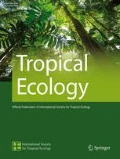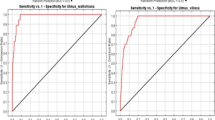Abstract
Climate change and human-centered development have endangered the survival of many species. The purpose of this study was to investigate, using MaxEnt, changes in the habitat suitable for the endangered palm Metroxylon vitiense (H. Wendl.) H. Wendl. ex Benth. & Hook. f. in Fiji resulting from a changed climate. MaxEnt is a maximum entropy-based machine learning program, and it can estimate the probability distribution for the occurrence of a species based on environmental constraints. The results indicated that precipitation in the driest month had the highest gain when it was considered in isolation, indicating that this factor is the most important environmental variable influencing the distribution of this palm. Moreover, precipitation in the driest quarter and annual precipitation may influence to some extent the distribution of the species. Predictions indicated that future suitable habitats for M. vitiense may occur not only in the coastal area, but also away from it. Although this prediction has associated uncertainty, the suitable area may increase to 409.7% and 240.9% of the area of current suitable habitats. The coastal area, where the current habitat it located, is subject to rapid development and may be affected by sea-level rise. In this case, ex situ conservation would be effective. In order to avoid risk, this study suggests that it would be appropriate to plant M. vitiense away from coastal areas. However, ensuring there is sufficient area for transplantation is a major issue.




Similar content being viewed by others
References
Ash J (1992) Vegetation ecology of Fiji: past, present, and future perspectives. Pac Sci 46(2):111–127
Beckage B, Osborne B, Gavin DG, Pucko C, Siccama T, Perkins T (2008) A rapid upward shift of a forest ecotone during 40 years of warming in the Green Mountains of Vermont. Proc Natl Acad Sci 105(11):4197–4202. https://doi.org/10.1073/pnas.0708921105
Beven K, Kirkby M (1979) A physically based, variable contributing area model of basin hydrology. Hydrol Sci J 24(1):43–69
Boatemaa MA, Addo KA, Mensah A (2013) Impacts of shoreline morphological change and sea level rise on mangroves: the case of the Keta coastal zone. J Environ Res Manage 4(11):359–367
Booth TH, Jovanovic T (2014) Climate change impacts on species planting domains: a preliminary assessment for selected plantation forests in Fiji, Papua New Guinea and the Solomon Islands. Int For Rev 16(2):191–198
Ehara H, Shibata H, Naito H, Mishima T, Ala P (2007) Na+ and K+ concentrations in different plant parts and physiological features of Metroxylon warburgii Becc. under salt stress. Jpn J Trop Agric 51:160–168
Ehara H, Shibata H, Prathumyot W, Naito H, Miyake H (2008a) Absorption and distribution of Na+, Cl− and some other ions and physiological features of sago palm under salt stress. Trop Agric Dev Dev 52:7–16
Ehara H, Shibata H, Prathumyot W, Naito H, Mishima T, Tuiwawa M, Naikatini A, Rounds I (2008b). Absorption and distribution of Na+ and some ions in seedlings of Metroxylon vitiense H. Wendl. ex Benth. & Hook. f. under salt stress. Tropical Agriculture and Development 52(1): 17–26
FAO (2017) Factsheet: People and Oceans. https://www.un.org/sustainabledevelopment/wp.../05/Ocean-fact-sheet-package.pdf. Accessed 12 Sep 2019
Fielding AH, Bell JF (1997) A review of methods for the assessment of prediction errors in conservation presence/absence models. Environ Conserv 24(1):38–49
Fiji Meteorological Service (2015) Current and future climate of the Fiji Islands, in Pacific-Australia Climate Change Science and Adaptation Planning Program, pp 1–10
GBIF.org (2021) GBIF occurrence download. https://doi.org/10.15468/dl.64paex. Accessed 1 Apr 2021
Gibson L, McNeill A, Tores PD, Wayne A, Yates C (2010) Will future climate change threaten a range restricted endemic species, the quokka (Setonix brachyurus), in south west Australia? Biol Cons 143(11):2453–2461
Gravelle G, Mimura N (2008) Vulnerability assessment of sea-level rise in Viti Levu, Fiji Islands. Sustain Sci 3(2):171–180
Guisan A, Thuiller W (2005) Predicting species distribution: offering more than simple habitat models. Ecol Lett 8(9):993–1009
Hijmans RJ, Cameron SE, Parra JL, Jones PG, Jarvis A (2005) Very high resolution interpolated climate surfaces for global land areas. Int J Climatol 25(15):1965–1978
Hope G, Stevenson J, Southern W (2009) Vegetation histories from the Fijian Islands: alternative records of human impact. In: Clark G, Anderson A (eds) The early prehistory of Fiji. ANUE Press, Canberra, pp 63–86
IPCC (2007) Climate Change 2007: the physical science basis, contribution of working group I to the fourth assessment report of the intergovernmental panel on climate change, S. Solomon et al., Eds. (Cambridge Univ. Press, Cambridge, 2007)
IPCC (2014) Climate Change 2014: Synthesis Report. In: Contribution of Working Groups I, II and III to the fifth assessment report of the intergovernmental panel on climate change retrieved from Geneva, Switzerland
IUCN/SSC (2014) Guidelines on the use of ex situ management for species conservation. In: Version 2.0. Gland, Switzerland: IUCN Species survival commission. https://www.eaza.net/assets/Uploads/Position-statements/IUCN-Guidelines-on-the-Use-of-ex-situ-management-for-species.pdf. Accessed 1 Apr 2021
Jonah FE, Boateng I, Osman A, Shimba MJ, Mensah EA, Adu-Boahen K, Chuku EO, Effah E (2016) Shoreline change analysis using end point rate and net shoreline movement statistics: An application to Elmina, Cape Coast and Moree section of Ghana’s coast. Reg Stud Mar Sci 7:19–31. https://doi.org/10.1016/j.rsma.2016.05.003
Kelly AE, Goulden ML (2008) Rapid shifts in plant distribution with recent climate change. Proc Natl Acad Sci 105(33):11823–11826
Lenoir J, Gégout JC, Marquet PA, de Ruffray P, Brisse H (2008) A significant upward shift in plant species optimum elevation during the 20th century. Science 320(5884):1768–1771. https://doi.org/10.1126/science.1156831
Loarie SR, Carter BE, Hayhoe K, McMahon S, Moe R, Knight CA, Ackerly DD (2008) Climate change and the future of California’s endemic flora. PLoS ONE 3(6):e2502
Manel S, Williams HC, Ormerod SJ (2001) Evaluating presence–absence models in ecology: the need to account for prevalence. J Appl Ecol 38(5):921–931
McClatchey W, Manner HI, Elevitch CR (2006) Elevitch, Craig R. (ed.) Metroxylon amicarum, M. paulcoxii, M. sagu, M. salomonense, M. vitiense, and M. warburgii (sago palm), ver. 2.1" (PDF). In: Species Profiles for Pacific Island Agroforestry. Hōlualoa, Hawai‘i. https://agroforestry.org/free-publications/traditional-tree-profiles. Accessed 12 Sep 2019
McNamara KE, Des Combes HJ (2015) Planning for community relocations due to climate change in Fiji. Int J Disaster Risk Sci 6(3):315–319
Mendoza-González G, Martínez ML, Rojas-Soto OR, Vázquez G, Gallego-Fernández JB (2013) Ecological niche modeling of coastal dune plants and future potential distribution in response to climate change and sea level rise. Glob Change Biol 19(8):2524–2535
Millennium Ecosystem Assessment (2005) Ecosystems and human well-being, vol 5. Island press, Washington
Mimura N, Nunn PD (1998) Trends of beach erosion and shoreline protection in rural Fiji. J Coast Res 14(1):34–46
Moore ID, Grayson RB, Ladson AR (1991) Digital terrain modelling: a review of hydrological, geomorphological, and biological applications. Hydrol Process 5(1):3–30
Morrison C, Rounds I, Watling D (2012) Conservation and management of the endangered Fiji Sago Palm, Metroxylon vitiense, in Fiji. Environ Manage 49:929–941
Petrosian H, Kar AD, Ashrafi S, Feghhi J (2016) Investigating environmental factors for locating mangrove ex-situ conservation zones using GIS spatial techniques and the logistic regression algorithm in mangrove forests in Iran. Polish J Environ Stud 25(5):2097–2106. https://doi.org/10.15244/pjoes/62640
Phillips SJ, Anderson RP, Schapire RE (2006) Maximum entropy modeling of species geographic distributions. Ecol Model 190(3):231–259
Rounds I (2007) Conservation, management and ethnobotany of Sago (Metroxylon vitiense) in South-East Viti Levu, Fiji Islands, University of the South Pacific: Suva, pp 1–111
Schmidt F, Persson A (2003) Comparison of DEM data capture and topographic wetness indices. Precis Agric 4(2):179–192
Tikoca S, Rivers MC (2017) Metroxylon vitiense. The IUCN red list of threatened species 2017: e.T177604A1494240. https://dx.doi.org/https://doi.org/10.2305/IUCN.UK.2017-3.RLTS.T177604A1494240.en. Accessed 1 Apr 2021
Tran Thi V, Tien Thi Xuan A, Phan Nguyen H, Dahdouh-Guebas F, Koedam N (2014) Application of remote sensing and GIS for detection of long-term mangrove shoreline changes in Mui Ca Mau, Vietnam. Biogeosciences 11(14):3781–3795
Watling D (2005) Palms of the Fiji Islands. Environmental consultants Ltd. Suva, Fiji, p 192
Watling D (2018) Conservation and Sustainable Utilization of the Fiji Sago Palm Metroxylon vitiense. In: Ehara H, Toyoda Y, Johnson D (eds) Sago palm. Springer, Singapore, pp 139–153
World Bank (2019) Population in Fiji. https://data.worldbank.org/country/fiji. Accessed 12 Sep 2019
Acknowledgements
We are deeply grateful to Prof. Isikawa who offered continuing support and constant encouragement. We are also indebted to Tomasi Junior Tawatatau SOVEA whose opinions and information have helped us very much throughout the production of this study. This study was supported by JSPS KAKENHI Grant no. JP15H05245.
Author information
Authors and Affiliations
Corresponding author
Rights and permissions
About this article
Cite this article
Itaya, A., Miyamori, M., Ehara, H. et al. Modeling future habitats to identify suitable sites for ex situ conservation of the endangered palm Metroxylon vitiense (H. Wendl.) H. Wendl. ex Benth. & Hook. f. in Fiji. Trop Ecol 63, 596–603 (2022). https://doi.org/10.1007/s42965-022-00233-1
Received:
Revised:
Accepted:
Published:
Issue Date:
DOI: https://doi.org/10.1007/s42965-022-00233-1




